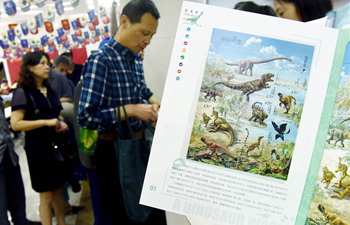SAN FRANCISCO, May 19 (Xinhua) -- Researchers at Stanford University have theorized that it could be early human population growth and migration that led to an explosion of new tools, art and other cultural artifacts around 50,000 years ago.
While modern humans and their immediate ancestors had been using tools for a few million years prior, the repertoire was limited. However, in the transition from the Middle to the Upper Paleolithic, there seemed to be a burst of cultural innovation.
The sudden early human cultural advance was usually assumed to be the result from climate or biological changes, namely external changes.
In a 2015 paper, Oren Kolodny, a postdoctoral fellow, Nicole Creanza, a former postdoctoral fellow, and Marcus Feldman, a professor of biology and co-director of Stanford's Center for Computational, Evolutionary and Human Genomics, argued that human culture could have evolved through three distinct kinds of advancement: first, some ideas emerge as "lucky leaps;" second, other ideas could emerge either as extensions of those leaps or as combinations of other ideas or technologies; finally, groups can also lose ideas.
Aided by computer simulations, the team showed that combining the three kinds of advancements could have led directly to bursts of innovation, as seen in the archaeological record. In addition, they found that at the point where new ideas balance out with lost ones, the number of ideas a population can support increases dramatically with population size.
Building on previous work, the researchers integrated two new components into their model: first, they considered migrations between otherwise distinct populations and assumed that such travel is more likely in larger populations; second, they studied what would happen if certain major innovations, such as domesticating plants or developing hunting knives, helped grow the population. The theory was published in the May issue of Royal Society Interface.
A population twice the size of Kolodny, Creanza and Feldman's model could support much more than twice the number of ideas.
In their new study, they predicted that when population sizes are small and migration is relatively rare, a pattern of cultural booms and bursts is likely. Then, without a steady stream of new ideas or population growth, some ideas will be lost to time.
Innovations that encouraged population growth, meanwhile, can have lasting effects, since even slight increases in population size can support a disproportionate increase in innovation.
Those theoretical conclusions could help explain a number of puzzles in human history, such as the disappearance of Neanderthals long ago.
"People tend to assume modern humans were better and replaced them," Kolodny said, but how they were better remains unclear. A simpler explanation may lie in two observations: Neanderthals had roughly a third the population of other early humans, and migration was always out of Africa, not into it. In that case, modern humans migrating from Africa might have brought with them a more advanced repertoire of technologies, due in part to their larger population, and Neanderthals just could not keep up.
"We don't think that whenever we get a qualitative pattern that looks like the archaeological record, this is what necessarily happened," Kolodny was quoted as saying in a news release from Stanford. "But it is a proof of concept that it could have happened this way."
Just as important, Creanza said, the results show that researchers cannot use cultural bursts as evidence of external changes. Just because our culture advanced 50,000 years ago it does not imply our brains got bigger, the landscape changed or anything else. It might just be the way culture is.



















